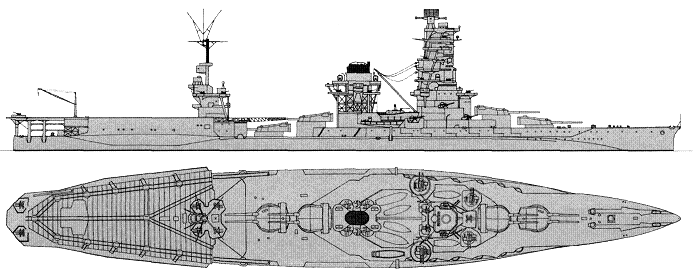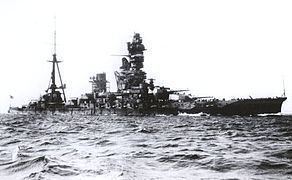Name Hyūga Ordered 1912 Commissioned 30 April 1918 Construction started 16 May 1915 Length 220 m | Laid down 16 May 1915 Struck 20 November 1945 Launched 27 January 1917 | |
 | ||
Builder | ||
Hyūga (日向), named for Hyūga Province in Kyūshū, was an Ise-class battleship of the Imperial Japanese Navy (IJN) laid down by Mitsubishi on 6 May 1915, launched on 27 January 1917 and completed on 30 April 1918. She was initially designed as the fourth ship of the Fusō-class, but was heavily redesigned to fix shortcomings. Hyūga was extensively updated and reconstructed from 1926–28 and 1934–36.
Contents

World War II

At the outbreak of the Pacific war, Hyūga was part of the battleship force at the Combined Fleet's anchorage at Hashirajima. On 7 December she sortied for the Bonin Islands, (known in Japan as the Ogasawara Group), along with her sister ship Ise of Battle Division 3 and with Nagato and Mutsu of Battle Division 1 as part of the reserve battle fleet for Operation Z (the attack on Pearl Harbor). The force returned to the Combined Fleet's anchorage at Hashirajima on 12 December 1941 and remained there until a 4 March raid against the Japanese base on Marcus Island (Minami Tori Shima), 1,200 miles (1,900 km) off the coast of Japan. The raid, commanded by Vice Admiral Halsey and Task Force 16 caused the IJN to sortie out in search of the American raiders. Halsey had steamed away at high speed once he recovered his aircraft and the Japanese were unable to make contact. April saw Halsey return, this time steaming within 650 miles (1,050 km) of the Japanese home islands along with the aircraft carrier Hornet of Task Force 18 to launch the Doolittle Raid. Once again Hyūga and the elements of the Combined Fleet sortied in chase, but Halsey and his group slipped away before the IJN could engage him.

In May 1942 while conducting gunnery practice along with Nagato, Mutsu, and Yamashiro, Hyūga's left gun breech in her No. 5 turret exploded, threatening the explosion of the magazine and the loss of the ship. Fifty-one crew members died in the explosion. The two aft magazines were rapidly flooded to save the ship. She returned to Kure for repairs. The number 5 turret was not replaced. Instead a circular sheet of steel plating was welded over the barbette and four 25 mm triple mount anti-aircraft guns were fitted in its place. She sortied with the rest of BatDiv2 on 29 May 1942 as a screening force for the Aleutians task force, along with CruDiv9: two light cruisers, twelve destroyers and the fleet oilers.
After the disastrous Battle of Midway, the Japanese Navy considered plans to convert all battleships besides Yamato and Musashi into aircraft carriers. Ultimately, the Navy decided that only Hyūga and Ise would be converted into hybrid battleship/carriers. Hyūga was reconstructed at the Sasebo Navy Yard from 1 May to 1 October 1943. Hyūga and her sister ship Ise had their two aft 356 mm (14 in) turrets (784 t (864 short tons) each) and barbettes (730 t (800 short tons) each) removed. They were replaced by a small flight deck and hangar to launch a squadron of aircraft. To compensate for the weight loss and to preserve metacentric height, the flight deck was covered with 203 mm (8 in) of concrete. A single elevator was fitted.
Anti-aircraft weapons were also added to better fight off aerial attack. Her complement of 8 Yokosuka D4Y dive bombers and 14 Aichi E16A seaplanes were catapult-launched, but landed either on conventional carriers or land bases. The seaplanes could also be hoisted back on board with a crane. Because production of aircraft was severely depleted by then, Hyūga never carried the full complement.
Hyūga participated in the Battle off Cape Engaño in October 1944, commanded by Rear Admiral Kusagawa Kiyoshi. She and Ise departed Japan for Singapore in November and returned in February 1945 during Operation Kita. She was later attacked during the bombing of Kure by American aircraft from the aircraft carriers USS Essex, Ticonderoga, Randolph, Hancock, Bennington, Monterey, and Bataan from 24–28 July 1945, and her crew ran the ship aground in shallow waters.
Fate
She was removed from the Navy List on 20 November 1945. From 2 July 1946 to 4 July 1947, she was raised and broken up by the Kure Dry-dock of Harima Zosen Yard.
